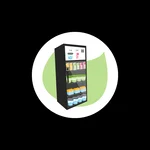What is RFID?
RFID, or radio frequency identification, is a wireless technology that uses radio waves to transfer data that is electronically stored on tags attached to a product or package. These tags contain a mixture of printed information, antenna and microchip. They can be read with an RFID reader from up to several feet away and do not need to be within direct line-of-sight of a reader to initiate interaction.
So-called passive tags are the most common type of RFID tag. Passive RFID tags are easily embedded in or attached to a wide variety of objects and do not require any battery.
The most notable difference between RFID tags and barcodes is that RFID tags can be read outside the line-of-sight, whereas barcodes must be aligned with the optical scanner to work. This means that RFID tags can be embedded in the object that needs to be tracked.
How does RFID work?
RFID is a method of Automatic Identification and Data Capture (AIDC). AIDC technologies automatically identify objects, collect data about the objects and enter that data into computer systems with little or no human intervention.
An RFID system consists of an RFID tag or smart label, an RFID reader and an antenna. The RFID tag contains an integrated circuit and an antenna that transmit data to the reader. The reader then converts the radio waves to a more usable form of data, and the information collected from the tags is transferred via a communications interface to a host computer system. There the data is stored in a database and can be analysed at a later time.
How is RFID used in business?
Automation is the main reason driving the increased adoption of RFID. Mass reading tags increases efficiency while decreasing the amount of manual labor that is involved in reading optical tags individually. RFID tags can hold much more data than barcodes, and they are not susceptible to the damages that barcodes are, such as tearing or smearing.
RFID technology is used in many industries to perform tasks such as inventory management, asset tracking, counterfeit prevention, ID badging, personnel tracking, controlling access to restricted areas and supply chain management.
In retail RFID tags are most commonly used for itemlevel tagging. In addition to inventory control, this provides protection against stealing, shrinkage and enables secure self-checkout for customers.
How is RFID used in Selfly Store?
In the Selfly Store use case, RFID is used to recognize the products inside the our smart vending machines. Every item inside the Selfly Store is tagged with an RFID tag, giving each products a unique identity. The RFID readers on the Selfly Store shelves keep track of the cabinet inventory in real time. All the data is stored in the Selfly Cloud. Thanks to this, Selfly Store merchants know exactly the stock of each Selfly Store cabinet, the products that have been sold or that need to be re-stocked, cutting down the need for manual labor. The sustainable ECO RFID tags used on products have an anti-tamper feature preventing any attempts to remove the tag from the product before the purchase transaction is completed.
Contact us

I’m interested in buying Selfly Store

I’m interested in reselling Selfly Store

